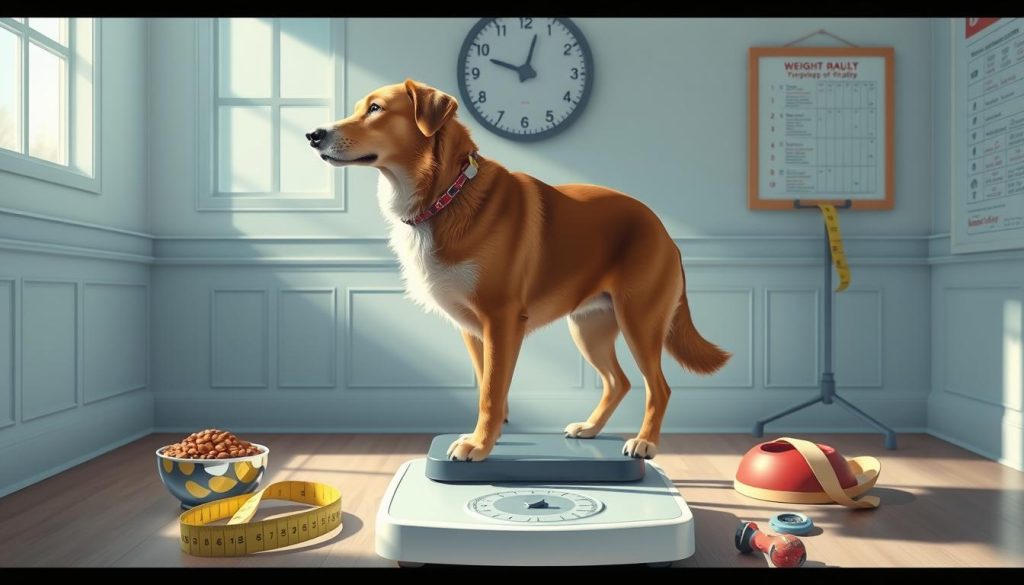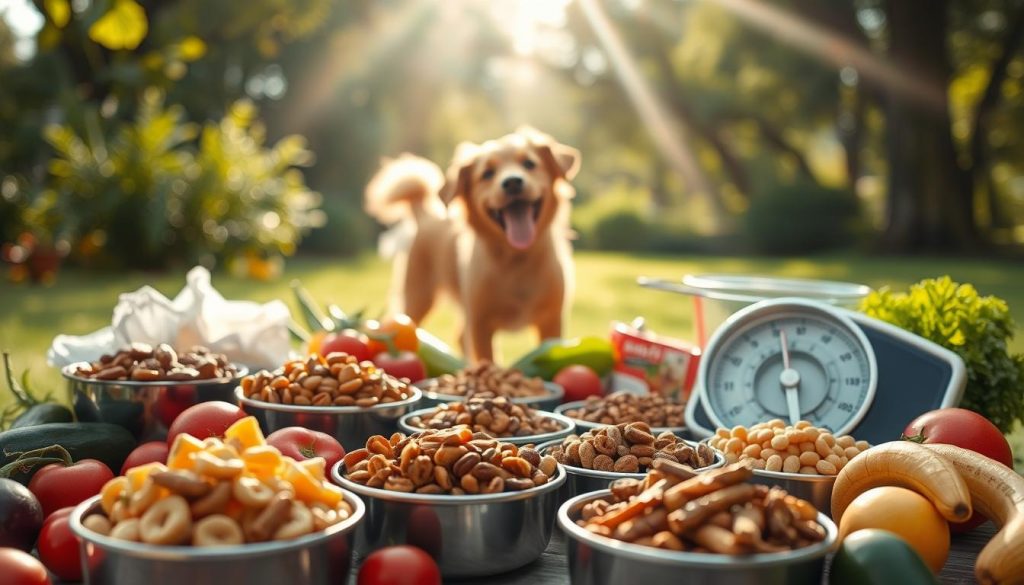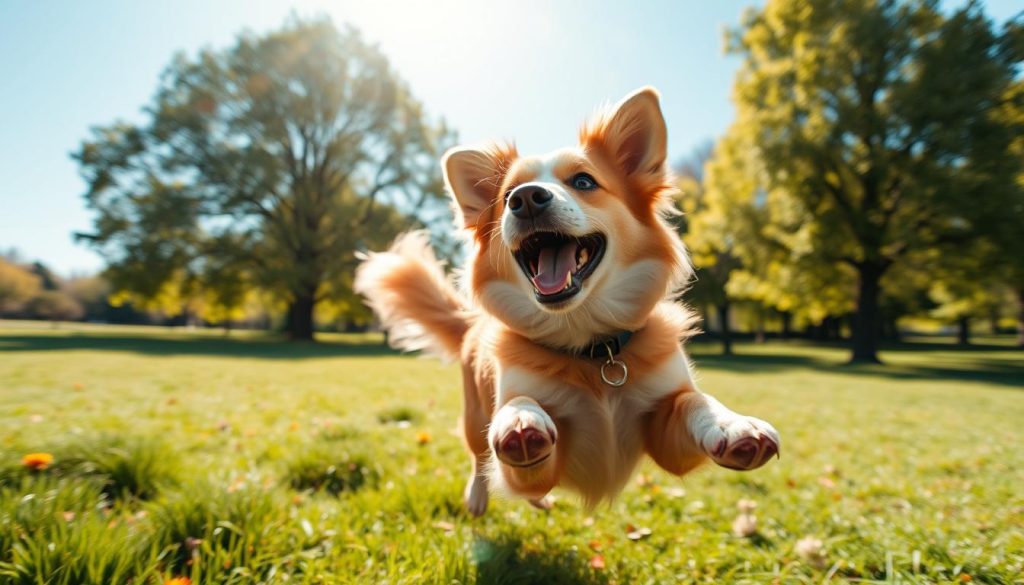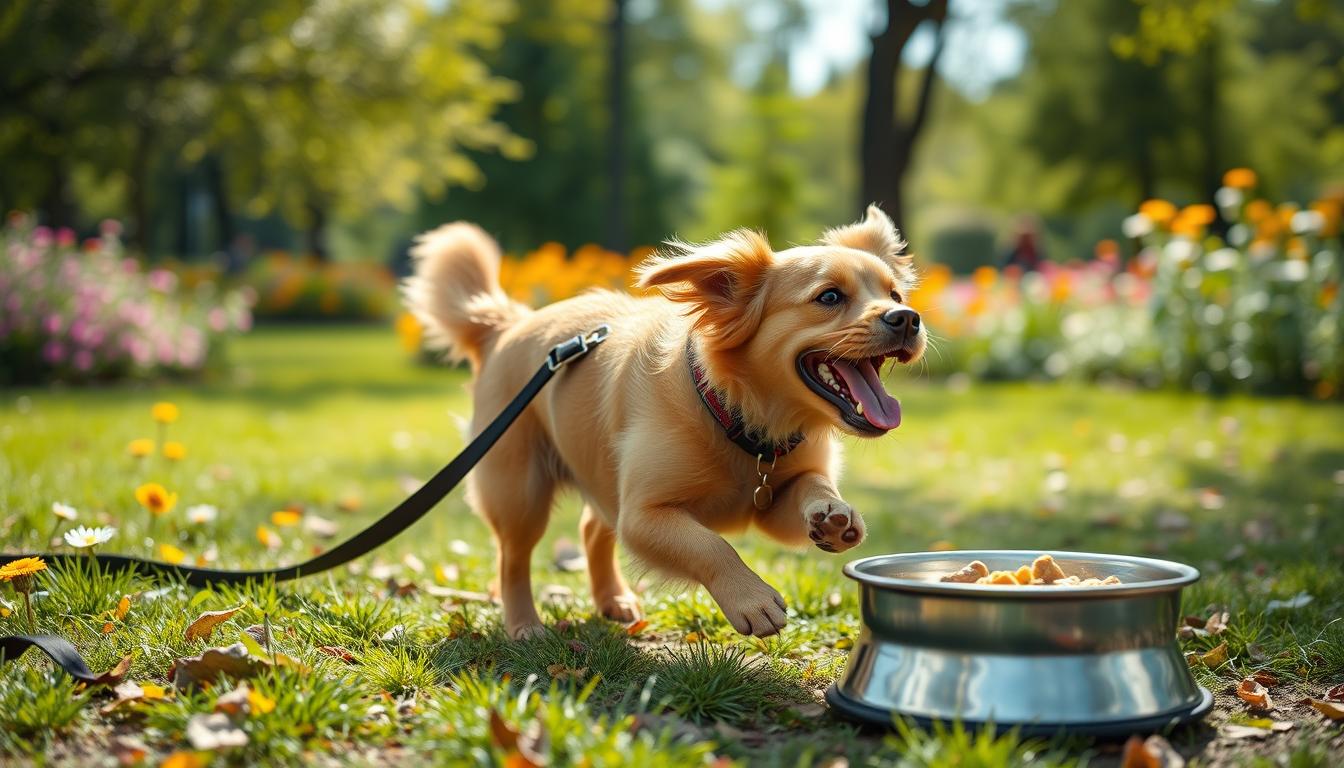As a devoted dog owner, I know how crucial it is to keep our furry friends at a healthy weight. They’re more than pets; they’re part of our family. That’s why I’m excited to share effective ways to keep your healthy dog in great shape.
In this guide, we’ll look at why keeping your dog at a healthy weight is so important. We’ll also talk about the dangers of dog obesity and how to help your pup stay at their optimal weight. You’ll learn how to check your dog’s body condition and how to balance their diet and exercise.
Let’s start this journey together to find the perfect dog fitness for your beloved pup. With the right steps, you can help your furry friend live a long, happy, and healthy life by your side.
The Importance of Maintaining a Healthy Weight for Dogs
Keeping your dog at a healthy weight is key for their health. Proper weight management offers many benefits. These include better joint health and a lower risk of chronic diseases. But, being overweight or underweight can cause serious health problems.
Benefits of Proper Weight Management
When your dog is at a healthy weight, they enjoy several benefits:
- Reduced strain on joints, minimizing the risk of arthritis and other mobility issues
- Improved cardiovascular health, reducing the chances of heart disease
- Increased energy levels, allowing your pup to be more active and playful
- Lower risk of developing metabolic disorders, such as diabetes
- Enhanced respiratory function, making it easier for your dog to breathe
Risks of Being Overweight or Underweight
Dogs that are overweight or underweight face serious health challenges:
- Overweight dogs are more susceptible to joint pain, respiratory problems, and heat intolerance
- Canine obesity increases the likelihood of developing life-threatening conditions like heart disease and certain types of cancer
- Underweight dogs may struggle with weakened immune systems, increased risk of infections, and malnutrition
- Extreme weight fluctuations can impact a dog’s overall lifespan and quality of life
Understanding the importance of dog weight management is crucial. It ensures your furry friend’s long-term health and happiness. By keeping them at their ideal weight, you help them thrive and enjoy being part of your family.
Assessing Your Dog’s Body Condition
Keeping your dog at a healthy weight is very important. The first thing to do is check their body condition. This means looking and feeling to see if they are at the right weight.
Start by looking at your dog from afar. Can you see their waist and feel their ribs without too much fat? If not, they might be too heavy. Then, feel their sides and back for a thin layer of fat over their bones. The right amount of fat means you can feel the ribs but not see them too much.
If your dog looks too skinny, you can see their bones easily. On the other hand, if they look too round, they might be too heavy. This is because you can’t see their waist and there’s too much fat.
| Body Condition Score | Description |
|---|---|
| 1-2 (Underweight) | Ribs, spine, and hip bones are visible. No fat cover. |
| 3-4 (Ideal) | Ribs can be felt with a slight fat cover. Waist is visible when viewed from above. |
| 5 (Overweight) | Ribs are difficult to feel. Abdominal fat deposits are present. No waist visible. |
Checking your dog’s body condition regularly helps keep them at a healthy weight. It’s all about dog body condition, evaluating dog weight, and canine body fat assessment. This way, your dog stays happy and healthy.
Calculating Your Dog’s Ideal Weight

Finding your dog’s ideal weight is key to a good weight management plan. Breed, age, and how active they are all play a part. By using formulas or online tools, you can figure out your dog’s target weight. Then, you can keep them at that weight with the right diet and exercise.
Factors Influencing Ideal Weight
Several things can affect your dog’s ideal weight. Here are some important ones:
- Breed: Different breeds have different body types and weights. Knowing your dog’s breed helps you find their healthy weight.
- Age: A dog’s weight needs change as they grow. Puppies and older dogs need different weights than adult dogs.
- Activity Level: How much your dog exercises affects their weight. Active dogs need more food to keep their energy up.
- Body Composition: Muscle, bone density, and body shape also matter. A lean, muscular dog might weigh more than a smaller one.
Think about these factors and use online calculators or talk to your vet. This way, you can find your dog’s healthy weight. Then, keep them there with a balanced diet and regular exercise.
Dog Weight Management: A Balanced Approach

Keeping your dog at a healthy weight is all about balance. It’s about giving them the right food and making sure they get enough exercise. Too much food can make them gain weight. So, it’s important to feed them the right amount based on their age, size, and how active they are.
Portion Control and Feeding Guidelines
To manage your dog’s weight, you need to control their portions. First, figure out what weight is best for your dog based on their breed, age, and how much they move. Then, use the feeding guidelines from your vet or the food maker to know how much to give them.
- Use a cup or scale to measure your dog’s food and make sure it’s the right amount.
- Don’t let your dog eat all the time because they might eat too much.
- Try giving them smaller meals throughout the day to keep their diet balanced and prevent overeating.
- Watch out for treats and table scraps because they can add too many calories to their diet.
| Dog Breed | Ideal Weight Range (lbs) | Recommended Daily Feeding (cups) |
|---|---|---|
| Labrador Retriever | 55-80 | 2-3 |
| Golden Retriever | 65-75 | 2-3 |
| Beagle | 20-30 | 1-2 |
| Chihuahua | 3-6 | 1/4-1/2 |
By following these guidelines and watching how much you feed your dog, you can help them stay healthy. This will keep them happy and well for a long time.
Incorporating Exercise into Your Dog’s Routine

Regular physical activity is key for your dog’s health and weight. The right exercise helps them stay fit and improves their heart health. It’s important to find an exercise plan that fits your dog’s breed, age, and needs.
Types of Exercise for Different Dog Breeds
Dogs need different amounts of exercise. Some breeds are very active, while others are more laid-back. Knowing your dog’s breed helps you choose the right exercise for them.
- High-energy breeds like Labradors, Huskies, and Border Collies love activities like running and hiking.
- Medium-energy breeds, such as Beagles and Bulldogs, enjoy brisk walks and playtime.
- Low-energy breeds, like Pugs and French Bulldogs, prefer gentle strolls and short play sessions.
It’s important to start slowly with your dog’s exercise. Gradually increase the time and intensity to avoid injuries and keep them interested.
| Breed | Exercise Needs | Recommended Activities |
|---|---|---|
| Labrador Retriever | High-energy | Running, hiking, agility training |
| Beagle | Medium-energy | Brisk walks, playtime, moderate exercise |
| Pug | Low-energy | Leisurely strolls, short playtime |
By matching your dog’s exercise to their needs, you help them stay healthy and at a good weight. Remember, dog exercise for weight management, exercise for different dog breeds, and physical activity for canine health are all important for your dog’s well-being.
Treating Obesity in Dogs
If your dog is overweight, it’s important to act fast to avoid health problems. There are good ways to help your dog lose weight safely. You can change their diet, increase exercise, and even use vet-supervised weight loss plans.
Start by talking to your vet about canine obesity. They can help figure out the right food and amount of calories for your dog. This might mean switching to a special dog food and controlling portions.
Adding more exercise is key for treating dog obesity. You can try longer walks, playtime at the park, or activities like swimming. Start slow to avoid injuries and keep your dog happy and healthy.

